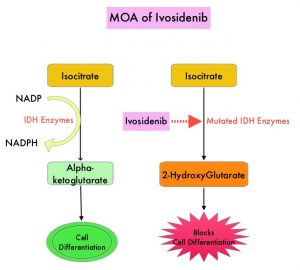SUMMARY: The Center for Disease Control and Prevention (CDC) estimates that approximately 1-2 per 1000 individuals develop Deep Vein Thrombosis (DVT)/Pulmonary Embolism (PE) each year in the United States, resulting in 60,000-100,000 deaths. Venous ThromboEmbolism (VTE) is the third leading cause of cardiovascular mortality, after myocardial infarction and stroke. Ambulatory cancer patients initiating chemotherapy are at varying risk for Venous Thromboembolism (VTE), which in turn can have a substantial effect on health care costs, with negative impact on quality of life.
Approximately 20% of cancer patients develop VTE and about 20% of all VTE cases occur in patients with cancer. There is a two-fold increase in the risk of recurrent thrombosis in patients with cancer, compared with those without cancer, and patients with cancer and VTE are at a markedly increased risk for morbidity and mortality. The high risk of recurrent VTE, as well as bleeding in this patient group, makes anticoagulant treatment challenging.
American Society of Hematology (ASH) formed a multidisciplinary guideline panel and the guidelines summarized below are based on updated and original systematic reviews of evidence, conducted under the direction of the McMaster University GRADE Center with international collaborators. The main objective is to support patients, clinicians, and other health care professionals in their decisions about the prevention and treatment of VTE in patients with cancer.
RECOMMENDATIONS
Primary prophylaxis for hospitalized medical patients with cancer.
♦ For patients without VTE, the panel suggests using thromboprophylaxis over no thromboprophylaxis and in whom pharmacologic thromboprophylaxis is used, the panel suggests using Low Molecular Weight Heparin (LMWH) over UnFractionated Heparin (UFH).
♦ For patients without VTE, the panel suggests using pharmacologic thromboprophylaxis over mechanical thromboprophylaxis or a combination of pharmacologic and mechanical thromboprophylaxis.
♦ For hospitalized medical patients with cancer, the ASH guideline panel suggests discontinuing thromboprophylaxis at the time of hospital discharge rather than continuing thromboprophylaxis beyond the discharge date.
Primary prophylaxis for patients with cancer undergoing surgery.
♦ For patients without VTE undergoing a surgical procedure at lower bleeding risk, the panel suggests using pharmacologic rather than mechanical thromboprophylaxis and for those undergoing a surgical procedure at high bleeding risk, the panel suggests using mechanical rather than pharmacologic thromboprophylaxis.
♦ For patients without VTE undergoing a surgical procedure at high risk for thrombosis, except in those at high risk of bleeding, the panel suggests using a combination of mechanical and pharmacologic thromboprophylaxis rather than mechanical prophylaxis alone or pharmacologic thromboprophylaxis alone.
♦ For all patients, the panel suggests using LMWH or Fondaparinux for thromboprophylaxis rather than UFH.
♦ The panel makes no recommendation on the use of Vitamin K Antagonists (VKAs) or Direct Oral AntiCoagulants (DOACs) for thromboprophylaxis, as there are no data.
♦ The panel suggests using postoperative thromboprophylaxis over preoperative thromboprophylaxis.
♦ For patients who have undergone a major abdominal/pelvic surgical procedure, the panel suggests continuing pharmacologic thromboprophylaxis, postdischarge rather than discontinuing at the time of hospital discharge.
Primary prophylaxis in ambulatory patients with cancer receiving systemic therapy.
♦ For patients at low and intermediate risk for thrombosis receiving systemic therapy, the panel recommends/suggests no thromboprophylaxis over parenteral thromboprophylaxis respectively. For patients at high risk, the panel suggests parenteral thromboprophylaxis (LMWH) over no thromboprophylaxis.
♦ The panel recommends no thromboprophylaxis over oral thromboprophylaxis with VKAs.
♦ For patients at low risk for thrombosis, the panel suggests no thromboprophylaxis over oral thromboprophylaxis with a DOAC (Apixaban or Rivaroxaban). For patients at intermediate risk, the panel suggests thromboprophylaxis with a DOAC (apixaban or rivaroxaban) or no thromboprophylaxis. For patients at high risk, the panel suggests thromboprophylaxis with a DOAC (Apixaban or Rivaroxaban) over no thromboprophylaxis.
♦ For patients with multiple myeloma receiving Lenalidomide, Thalidomide, or Pomalidomide-based regimens, the panel suggests using low-dose Aspirin or fixed low-dose VKAs or LMWH.
Primary prophylaxis for patients with cancer with Central Venous Catheter (CVC).
♦ The panel suggests not using parenteral or oral thromboprophylaxis.
Initial treatment (first week) for patients with active cancer and VTE.
♦ The panel suggests DOAC (Apixaban or Rivaroxaban) or LMWH be used for initial treatment of VTE.
♦ The panel recommends/suggests LMWH over UFH and Fondaparinux respectively, for initial treatment of VTE.
Short-term treatment for patients with active cancer (initial 3-6 months).
♦ The panel suggests DOACs (Apixaban, Edoxaban, or Rivaroxaban) over LMWH and VKAs, and LMWH over VKAs.
♦ For patients with incidental (unsuspected) Pulmonary Embolism (PE), or SubSegmental PE (SSPE), the panel suggests short-term anticoagulation treatment rather than observation.
♦ For patients with visceral/splanchnic vein thrombosis, the panel suggests treatment with short-term anticoagulation or observation.
♦ For patients with CVC-related VTE receiving anticoagulant treatment, the panel suggests keeping the CVC over removing the CVC.
♦ For patients with recurrent VTE despite receiving therapeutic LMWH, the panel suggests increasing the LMWH dose to a supratherapeutic level or continuing with a therapeutic dose.
♦ For patients with recurrent VTE despite anticoagulation treatment, the panel suggests not using an Inferior Vena Cava filter over using a filter.
Long-term treatment (>6 months) for patients with active cancer and VTE.
♦ The panel suggests long-term anticoagulation for secondary prophylaxis (> 6 months) rather than short-term treatment alone (3-6 months), and the panel suggests continuing indefinite anticoagulation over stopping after completion of a definitive period of anticoagulation.
♦ For patients requiring long-term anticoagulation (> 6 months), the panel suggests using DOACs or LMWH.
American Society of Hematology 2021 guidelines for management of venous thromboembolism: prevention and treatment in patients with cancer. Lyman GH, Carrier M, Ay C, et al. Blood Adv 2021;5: 927–974.

